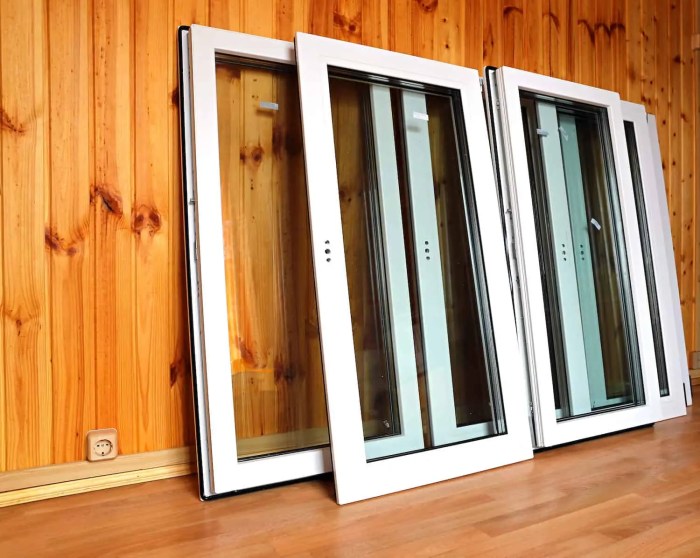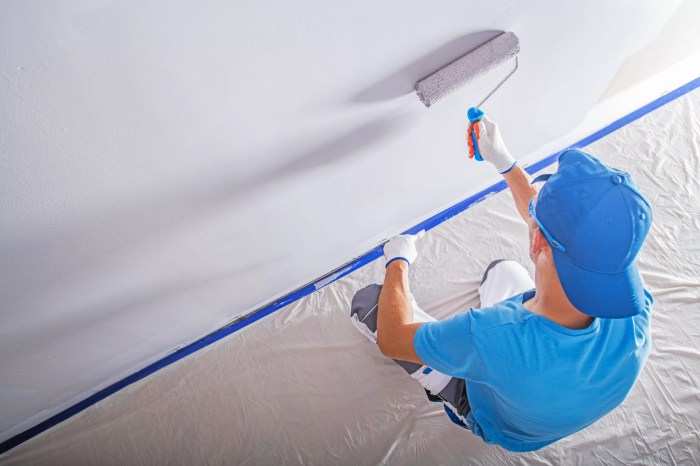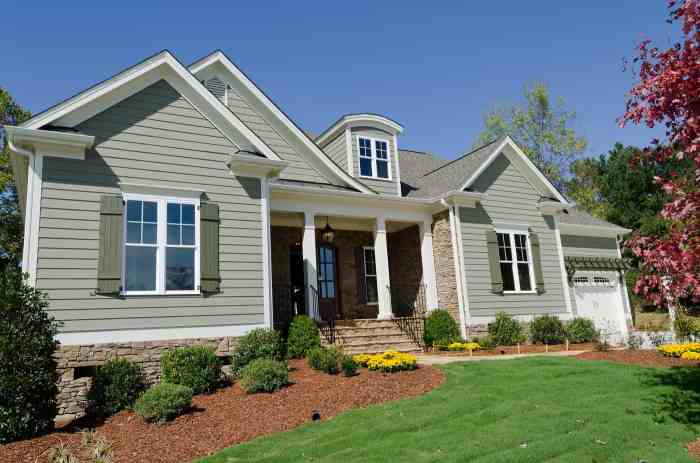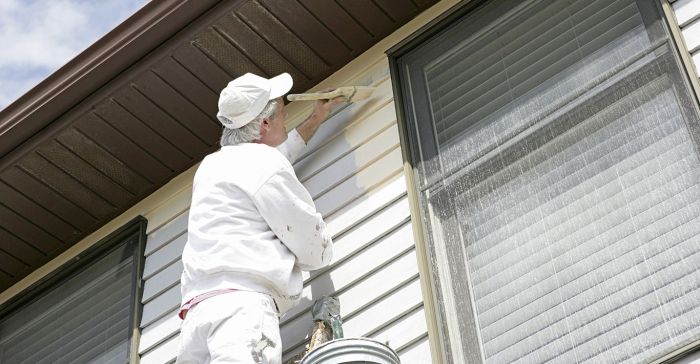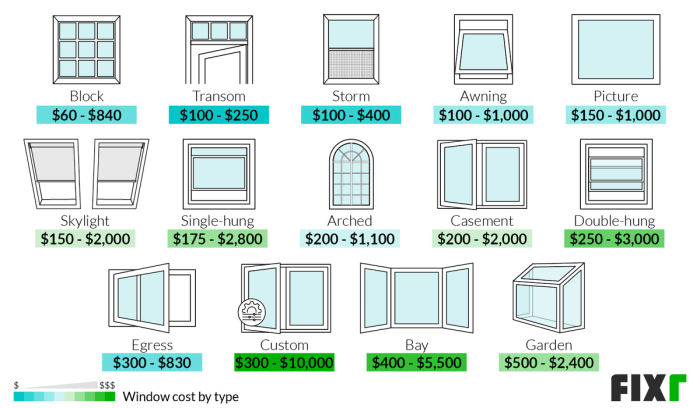Modern vs. Traditional Front Doors: What Suits Your Home?
Modern vs. Traditional Front Doors: What Suits Your Home? sets the stage for this enthralling narrative, offering readers a glimpse into a story that is rich in detail and brimming with originality from the outset.
As we delve into the world of front door choices, we explore the key characteristics, factors to consider, material selection, and design aspects that play a crucial role in defining the entrance to your home.
Modern vs. Traditional Front Doors
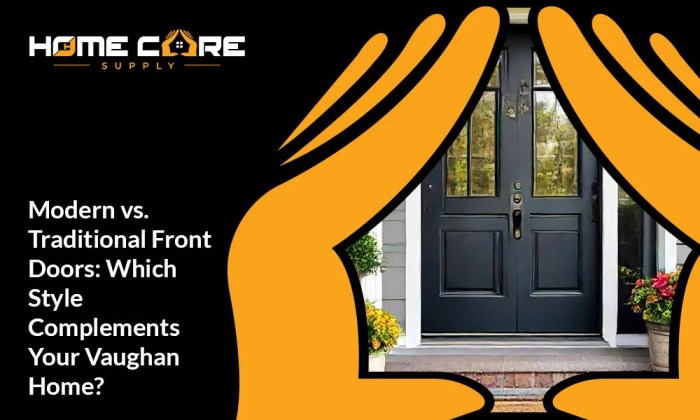
When it comes to front doors, there are distinct styles that can greatly impact the overall look of your home. Modern and traditional front doors each have their own unique characteristics that cater to different preferences and architectural styles.
Key Characteristics of Modern Front Doors
Modern front doors are known for their sleek and minimalist design. They often feature clean lines, geometric shapes, and contemporary materials such as glass, metal, and fiberglass. These doors prioritize simplicity and functionality, creating a bold statement for a modern home.
Typical Features of Traditional Front Doors
Traditional front doors, on the other hand, are characterized by classic and timeless designs. They usually incorporate elements like wood paneling, ornate carvings, and traditional hardware such as brass handles and knockers. These doors exude a sense of warmth and charm, perfect for homes with a more traditional or historic aesthetic.
Comparison of Design Elements
- Material: Modern doors often use glass, metal, and fiberglass, while traditional doors are typically made of wood.
- Color: Modern doors tend to have bold and vibrant colors, whereas traditional doors are more likely to have earthy tones or classic finishes like stained wood.
- Hardware: Modern doors feature sleek and minimalistic hardware, while traditional doors showcase ornate handles, hinges, and other decorative elements.
- Design Details: Modern doors focus on clean lines and simplicity, while traditional doors embrace intricate carvings, panels, and moldings.
Factors to Consider
When deciding between a modern or traditional front door for your home, there are several important factors to take into consideration that can influence your choice.
Architectural Style of Your Home
The architectural style of your home plays a significant role in determining whether a modern or traditional front door would be the best fit. For example, if you have a sleek and contemporary home design, a modern front door with clean lines and minimalist features may complement the overall aesthetic.
On the other hand, if your home has a more classic or historical style, a traditional front door with intricate details and ornate embellishments could enhance its charm and character.
Importance of Security
Security is a crucial factor to consider when choosing a front door for your home. Modern front doors are often equipped with advanced locking mechanisms and materials that provide enhanced security features, such as reinforced steel or smart locks. Traditional front doors, while they may offer a more classic look, may not always provide the same level of security as their modern counterparts.
Assessing your security needs and prioritizing safety can help guide your decision between modern and traditional front doors.
Climate and Weather Conditions
The climate and weather conditions of your region can also impact your choice of front door style. For example, if you live in an area with extreme temperatures or frequent harsh weather conditions, a modern front door made of durable materials like fiberglass or steel may be more suitable due to their weather-resistant properties.
Traditional wooden doors, while aesthetically pleasing, may require more maintenance and could be prone to warping or rotting in certain climates. Considering the weather challenges in your region can help you select a front door that will withstand the elements and provide long-lasting functionality for your home.
Material Selection
When it comes to choosing the material for your front door, it's essential to consider both the aesthetic appeal and the practical aspects. Different materials offer varying levels of durability, maintenance requirements, and overall style. Let's explore the common materials used in modern and traditional front doors.
Modern Front Doors
Modern front doors often feature sleek and contemporary materials that add a touch of sophistication to the home's exterior. Some of the common materials used in modern front doors include:
- Steel: Known for its strength and security, steel front doors are durable and resistant to harsh weather conditions. They are low maintenance and can be painted in various colors to suit different architectural styles.
- Fiberglass: Fiberglass front doors mimic the look of wood but are more durable and require less maintenance. They are energy-efficient and offer excellent insulation properties.
- Glass: Glass front doors are a popular choice for modern homes as they allow natural light to enter the space and create a welcoming ambiance. They can be customized with different finishes and textures for added style.
Traditional Front Doors
Traditional front doors often feature classic materials that exude timeless charm and elegance. Some of the traditional materials used in crafting front doors include:
- Wood: Wood front doors are a staple in traditional homes, offering a warm and inviting look. They can be made from various wood species like mahogany, oak, or cherry, each with its unique grain pattern and color.
- Wrought Iron: Wrought iron front doors are known for their intricate designs and decorative details. They are durable and provide an added layer of security to the home.
- Stained Glass: Stained glass front doors are a hallmark of traditional architecture, featuring colorful and intricate designs that add character to the home's facade.
Durability and Maintenance
When it comes to durability and maintenance, each material has its pros and cons. Steel doors are highly durable but may dent or rust over time, while fiberglass doors are low maintenance but may fade or crack in extreme conditions.
Wood doors offer a classic look but require regular maintenance to prevent warping or rotting. Glass doors are elegant but may require more cleaning to maintain their appearance.Consider the climate, architectural style, and personal preferences when choosing the material for your front door to ensure it complements your home's overall look and provides the desired level of durability and maintenance ease.
Design and Aesthetics
When selecting a front door for your home, it's crucial to consider the design and aesthetics to ensure it complements the overall look of your property. The front door is not just a functional element but also a key focal point that can enhance the curb appeal of your home.
Selecting Front Door Design
- Consider the architectural style of your home - Choose a front door design that aligns with the architectural style of your property. For modern homes, sleek and minimalist designs work well, while traditional homes may benefit from more ornate and classic designs.
- Balance and proportion - Ensure that the size and style of the front door are in proportion to the facade of your home. A well-balanced design can create a cohesive look.
- Personal taste - Ultimately, your front door should reflect your personal style and taste. Whether you prefer a bold and colorful door or a more understated design, choose something that resonates with you.
Role of Color and Finishes
- Color impact - The color of your front door can make a significant impact on the overall look of your home. Bold and bright colors can add character and charm, while neutral tones can create a more subtle and elegant appearance.
- Finish options - Consider different finishes such as matte, glossy, or textured finishes to add depth and interest to your front door. The right finish can elevate the aesthetics of your entryway.
- Contrast and coordination - Think about how the color and finish of your front door will contrast or coordinate with the rest of your home's exterior. Creating a harmonious color palette can enhance the curb appeal.
Decorative Elements
- Hardware accents - Incorporating decorative hardware such as handles, knockers, and hinges can add a touch of elegance to both modern and traditional front door designs.
- Glass inserts - Consider adding decorative glass inserts to your front door to introduce natural light and visual interest. Frosted, stained, or textured glass can enhance the aesthetics of your entryway.
- Trim and molding - Adding decorative trim or molding around your front door can create a sense of grandeur and sophistication. Intricate details can elevate the overall design of your entry.
Epilogue
In conclusion, the debate between modern and traditional front doors is a nuanced one, with each style offering its own unique charm and benefits. Ultimately, the decision comes down to personal preference, home aesthetics, and practical considerations.
FAQ
Which front door style is more secure, modern or traditional?
Both modern and traditional front doors can be secure, but modern doors often come with advanced locking systems for added security. It's essential to choose a door that meets your security needs.
Are modern front doors more expensive than traditional ones?
The cost of front doors can vary based on the materials used and the level of customization. In general, modern front doors tend to be more expensive due to the use of innovative materials and designs.
Can traditional front doors withstand harsh weather conditions?
Traditional front doors crafted from sturdy materials like wood can withstand harsh weather conditions with proper maintenance. It's important to protect them from excessive exposure to elements.
